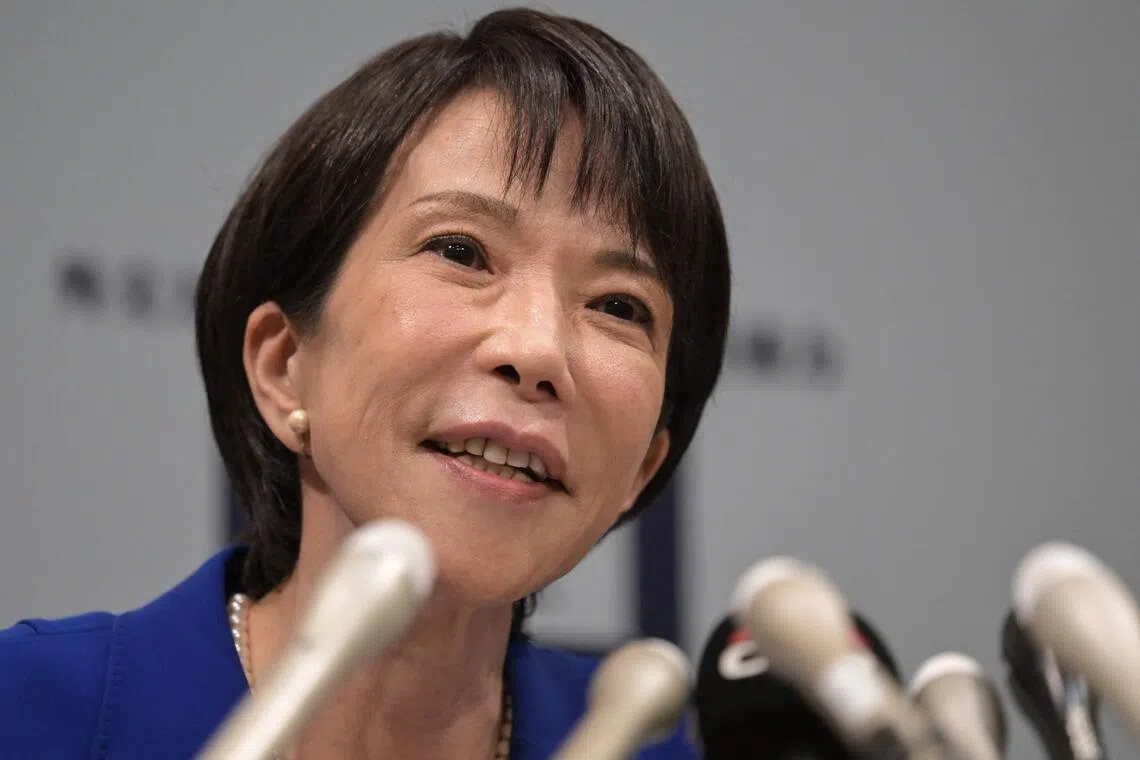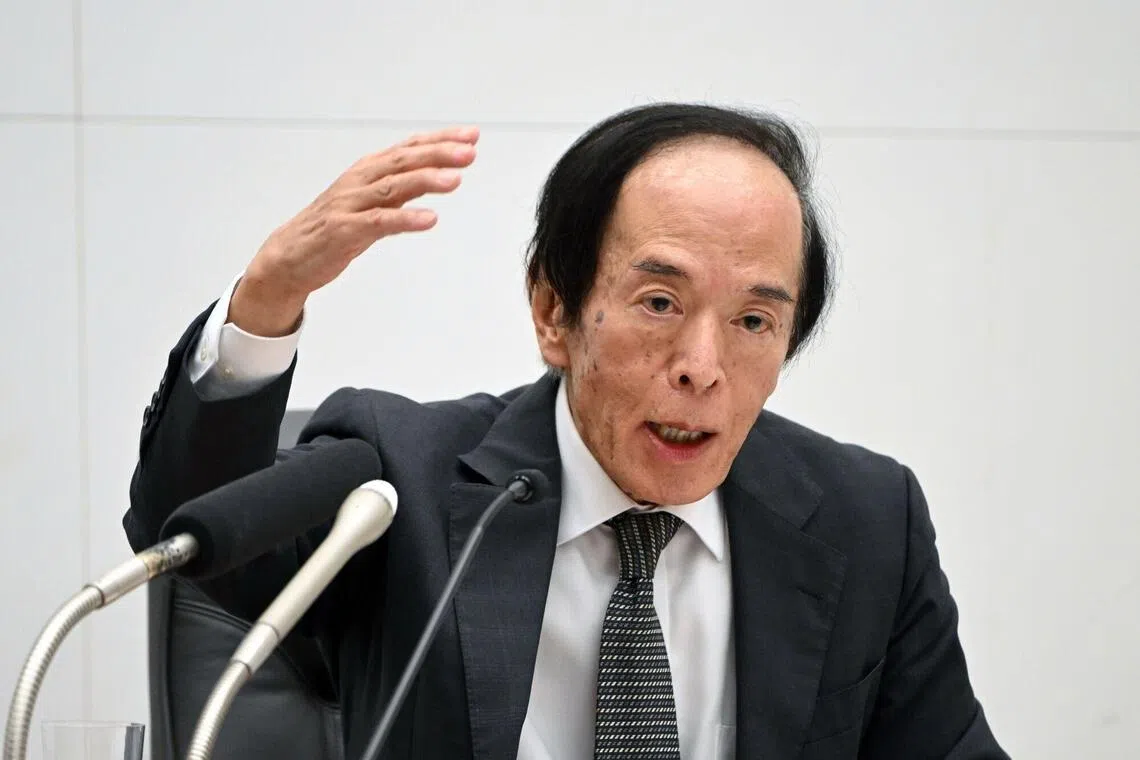Japan’s LDP leadership race kicks off with 5 contenders
Sign up now: Get ST's newsletters delivered to your inbox

Pro-stimulus, conservative politician Sanae Takaichi is among those tipped to become Japan’s next prime minister.
PHOTO: AFP
Follow topic:
TOKYO – Japan’s ruling party leadership race formally kicked off on Sept 22 under close market scrutiny, with the outcome likely to determine who will lead the nation following Prime Minister Shigeru Ishiba’s decision to step down
The five candidates will face off in the party’s Oct 4 presidential election, and the winner will face the urgent task of rebranding the Liberal Democratic Party (LDP) to stop a drift of supporters to rival populist parties that have stripped the LDP of its majorities in both chambers of Parliament in recent elections.
The victor is expected to become prime minister through a parliamentary vote, tasked with steering Japan through mounting challenges, including persistent inflation, an increasingly tense regional security environment and relations with US President Donald Trump.
Among the five leadership hopefuls, most local media polls suggest that pro-stimulus, conservative Sanae Takaichi and reform-minded younger politician Shinjiro Koizumi are the front runners.
Investors are largely viewing Ms Takaichi as a leader who would ramp up fiscal support for the economy and slow down the Bank of Japan’s (BOJ) interest rate hikes, while Mr Koizumi would take a more fiscally cautious view while leaving the central bank to press ahead with normalisation.
While Ms Takaichi largely refrained from talking about policy proposals, she struck a hard tone on issues regarding foreigners, a topic pressed by the Sanseito party that made inroads into the LDP’s conservative camp in the July national election.
“I intend to consider from scratch how we can build peaceful, mutually respectful relationships with foreigners,” she said. “Year after year, we keep bringing in people whose cultures and everything else are so vastly different from ours. This policy simply must be re-evaluated.”
Mr Koizumi also touched on concerns among Japanese citizens over issues pertaining to foreigners, such as illegal workers.
While he pledged to take fresh economic measures immediately with an extra budget to help people cope with inflation, he also struck a humble tone in noting that the LDP cannot get things done alone any longer as a minority government.
“Before launching any new policies with fanfare, I believe the only way to restore trust is to unite and steadily implement what we promised the people, what we agreed with the opposition parties and what the people are asking for,” he said.
The other three candidates are Chief Cabinet Secretary Yoshimasa Hayashi, the closest to a continuity candidate from Mr Ishiba; former economic security minister Takayuki Kobayashi, a younger conservative alternative to Ms Takaichi; and former party policy chief Toshimitsu Motegi, who has touted the negotiation prowess he displayed during Mr Trump’s first administration.
All candidates are largely aligned on the importance of the alliance with the US, while Ms Takaichi is seen as more cautious in her views on China, with Mr Hayashi seen as the most pro-Beijing.
While Mr Ishiba concluded a trade deal
The new leader is also expected to face US pressure going ahead on defence spending and the cost of hosting US troops in Japan.
Starting line
The vote will be held in a “full-scale” format, with the party’s 295 parliamentary lawmakers each casting one ballot, while another 295 votes will be distributed among the broader membership base, which totals 916,000, according to the latest LDP figures.
In the 2024 leadership race, Mr Ishiba and Ms Takaichi won more than 200,000 votes each from local members. Together with Mr Koizumi, who won more than 100,000 votes from members, they were far ahead of the other six candidates.
All five contenders are returning from that race and appear to have adjusted their strategies to adopt a more moderate tone this time. If they maintain this softer stance, turbulence in bond and currency markets may be more limited than first feared when the leadership race was called.
A poll by the Asahi newspaper over the weekend showed a divergence between the public and LDP supporters.
Ms Takaichi was the top choice among the public, with a 28 per cent to 24 per cent lead over Mr Koizumi, while she trailed him 24 per cent to 41 per cent among LDP supporters. Mr Hayashi came in third in both groups, around the 10 per cent mark.
Ms Takaichi, known for advocating stimulus measures and easy monetary policy, notably avoided monetary policy references during a 90-minute press conference on Sept 19.
Instead, she pledged more pragmatic tax relief and direct cash payments, proposals that may have less market impact. The possibility of a Takaichi win has fuelled concerns about Japan’s already-strained public finances, pushing bond yields higher and the yen weaker in recent weeks.
Mr Koizumi, son of former LDP prime minister Junichiro Koizumi, lost early momentum in the 2024 campaign after hinting at labour market reforms.
This time around, he is aligning his campaign much closer to the existing policy direction under Mr Ishiba, with Finance Minister Katsunobu Kato helping run his campaign – a factor that may help compensate for his relatively limited political experience.
The 44-year-old pledged fresh economic measures to counter inflation on Sept 20, and said he would look to finance them with surplus tax revenue.

Japan has been struggling with decades of deflation and stagnant domestic demand.
PHOTO: BLOOMBERG
Having lost control of both legislative chambers, the new coalition leader will need to cooperate with other parties to advance any legislation.
Small kingmaker parties the Democratic Party for the People, the Japan Innovation Party and emerging far-right Sanseito are seen as potential partners of the ruling coalition.
The smaller opposition parties have been calling for a reduction in the sales tax to help households deal with the cost-of-living crunch caused by inflation, a move that would widen the hole in government finances.
How to deal with the BOJ
The need for the LDP to gain opposition cooperation has fuelled concerns that whoever wins will have to loosen fiscal discipline to ensure passage of legislation.
Raising interest rates would help curb inflation, but could also hit growth if carried out too quickly.

Bank of Japan governor Kazuo Ueda talking to reporters after the central bank took another step towards policy normalisation.
PHOTO: BLOOMBERG
While Ms Takaichi sharply criticised the BOJ for raising rates in 2024, she has steered clear of talking in depth about monetary policy this time.
Still, market players view her as the candidate most likely to slow down the BOJ’s normalisation campaign. The other candidates have largely said monetary policy should be left to the central bank.
The BOJ left its benchmark interest rate unchanged at 0.5 per cent last week, though it is expected to hike again in the coming months, with an October move still seen as a possibility.
Other contentious issues where the candidates may differentiate themselves include controls on foreign residents in Japan, energy policy and agricultural policy. BLOOMBERG

